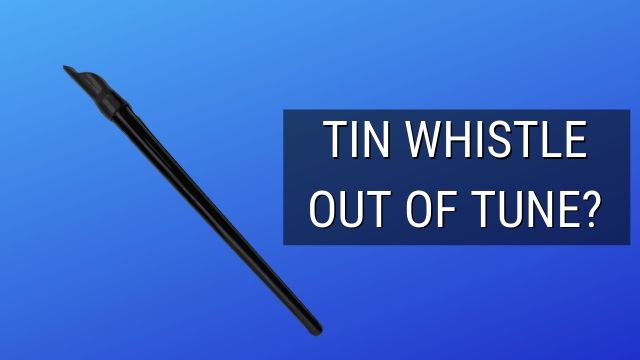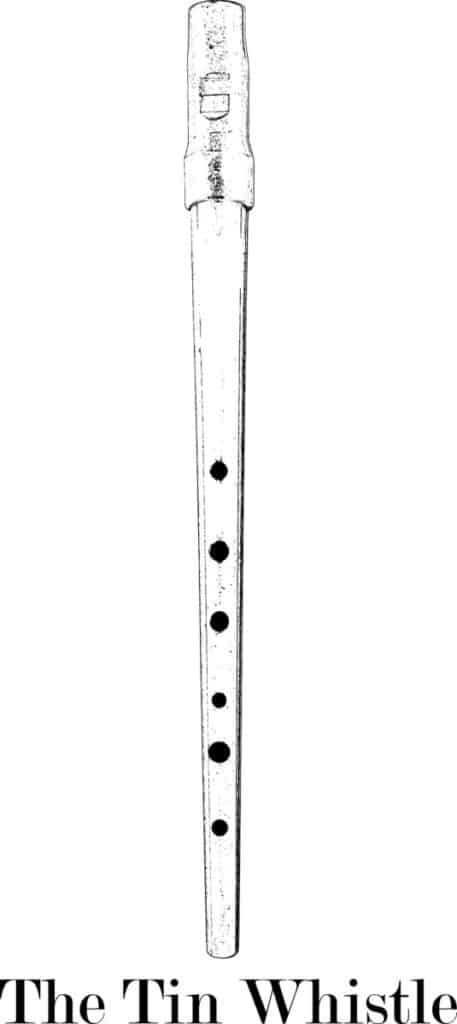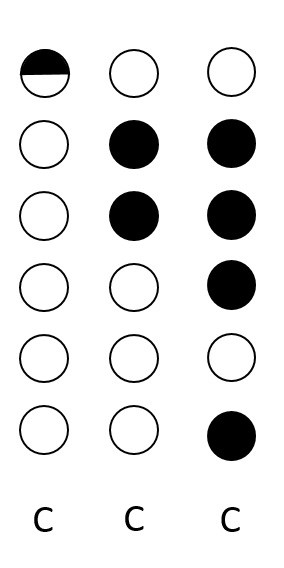This post contains affiliate links. We earn commissions if you purchase products from retailers after clicking on a link from our site. As an Amazon Associate, we earn from qualifying purchases.
A tin whistle is designed with 6 holes that don’t move, and the shape of your mouth (the embouchure) has much less to do with sound than other instruments–does this mean that it’s not possible for a tin whistle to be out of tune?

By the way, looking for recording equipment and musical instruments? Check out Sweetwater.com for microphones, monitors, audio interface or any other recording gear that you could ever need. (Affiliate Link)
A tin whistle can be out of tune for several reasons:
- The tin whistle’s design is flawed due to hole size and spacing
- Unintended defects with the whistle such as shape and angle of the ramp and windway
- The player’s air speed may be above or below the ideal level
- The tin whistle is cold and needs to be warmed up
- The tuning slide is not properly adjusted (only applicable to tin whistles with tuning slides)
Turns out there are a lot of reasons why a tin whistle may be out of tune! You would think that a tin whistle, especially a non-tunable tin whistle, would always be in tune, but it turns out there are lots of reasons why. Let’s talk about why tin whistles can be out of tune and some ways you can help it.
Ways Tin Whistles Can Be Out of Tune And How to Fix Them
First off, what is being out-of-tune mean? Well, that could be an entire discussion all on its own, but in short: an instrument which pitch is higher or lower than the standardized pitch (for example, the standard for A is 440HZ). Furthermore, an instrument can be out-of-tune in reference to another instrument being played.
So, when I say a tin whistle can be out of tune, there are two ways I mean here:
- Generally out-of-tune
- Out of tune on particular notes
What I mean by generally out-of-tune is that the every note you play is out of tune with standardized pitch, or perhaps you are playing with another instrument that cannot be tuned or an instrument that is difficult to tune (like a piano)–and the two instruments are out-of-tune with each other.
It’s possible on the tin whistle to be out-of-tune only for particular notes, which is a much more tricky problem to solve. Let’s talk about reasons why and things you can do about it.
Tin Whistle Design
It can be frustrating to think about, but it’s possible that the design of the tin whistle is flawed in itself–meaning that the tin whistle, from no fault of your own, is going to either be generally out-of-tune or always out-of-tune on particular notes because the way the tin whistle is designed:
How can whistle design affect intonation?
Take a look at this picture and I’ll show you what I mean:

This is a diagram of a tin whistle. As you probably know by now, the tin whistle has 6 holes in the front of the instrument. The distance between the holes and the size of the holes are what causes the change in pitch when you cover or uncover the holes.
If you look closely, you can see that the holes in the tin whistles are not at the same distance from one another. Furthermore, on close inspection you can see that the holes are not the same size, either. This isn’t by accident–these are spaced and sized to give the proper pitch when played.
The hole spacing, the hole sizes, and the length of the bore all play a role in pitch. If one of those factors is off, then you will have either the entire whistle be out of tune (fixable), or particular notes (trickier to fix).
How Can You Overcome Tin Whistle Design Flaws and Play In Tune?
Adjusting the Tuning Slide
If the whistle is generally out-of-tune, but the notes are a proper distance apart, you may be in luck. You might be able to fix it by adjusting the mouthpiece with a tuning slide. If your whistle doesn’t have a tuning slide, you might be able to make a makeshift tuning slide. See the below section for more details.
If only a couple of notes are out-of-tune, then this is tricker to handle–however you can experiment with alternate fingerings.
Alternate Fingerings
Many notes have alternate fingerings that not only provide another way to play a note for convenience, but also, the intonation (a fancy word for whether a note is in tune or not) is also different from fingering to fingering.

In the figure above, you can see three different ways to play C on a D-scale tin whistle. The middle fingering is covering the 2nd and 3rd holes, while the rightmost fingering is covering the 2nd, 3rd, the 4th, and 6th holes. The first fingering is half covering the 1st hole. Partially covering holes is the most flexible way to adjust the pitch–you have full control of making a particular note more sharp or more flat.
Defects With The Whistle
Another reason why your whistle might be out-of-tune is due to a defect unrelated to the design of the whistle.
The tin whistle is a pretty simple instrument in concept, but it turns out that very small adjustments can affect the tone of the instrument and whether it’s in tune or not.
The area that you blow into is called the mouthpiece. The empty column that you fill with air that exits out the hole in the mouthpiece and through the rest of the instrument is called the windway. The windway is interrupted by a ramp (this is that small ramp that slope downward into the hole in the mouthpiece). The ramp is a delicate part of the the instrument which heavily impacts the sound of the instrument.
How Can You Overcome Tin Whistle Defects Flaws and Play In Tune?
**warning** be very careful doing any adjustments to your whistle. I cannot be held responsible for any damage that may happen. I’ll try and warn you about any dangerous operation.
If the ramp is somehow bent, or, if there is an obstruction in the windway due to a manufacturing issue, or if there is an air leak–all of these will change your tone and likely your pitch as well, potentially taking you out-of-tune. Using a thin, sharp object (like a sewing needle), you can work these plastic blockages out.
Adjusting the ramp is a tricky and potentially dangerous thing to do since any changes are really hard to undo. Some will change the shape of their ramp or may even overlay it with another piece of plastic to adjust the sound. You can try using mounting putting to temporarily put something in place without gluing so as to experiment and not damage your tin whistle.
Some defects are not fixable or are not easily fixable. If there’s an issue and there’s nothing you can do about it, you can use the methods I’ve mentioned above (using the tuning slide if possible or trying alternate fingerings)
Issues in Air Speed
The tin whistle works by air that oscillates back and forth rapidly. Ultimately, the speed of the air blown out of your mouth and into the mouthpiece is what creates the sound. You can slightly bend the pitch of the note if you are playing too softly or too forcefully.
This isn’t an easy thing to fix since it’s mostly second-nature. Try to shoot for the middle of the road giving plenty of air support and not too much where you are often shooting up into the higher octaves.
Cold Whistle
If you are playing outside, or in a large space that’s difficult to change the temperature (like an auditorium) or are just picking up whistle after not playing for a minute or two, you may experience cold whistle syndrome, which leads to your tin whistle sounding flat. Your tin whistle will be generally out of tune.
Okay… so I may have just made up that term–but the struggle is real!
Basically, since your tin whistle works by air pressure and the oscillation (rapid movement back and forth) of that air pressure, the temperature of the whistle can impact how fast the air can move back and forth.
TL;DR: Cold Whistle = out of tune
How Do You Warm Up a Cold Whistle and Play In Tune?
Luckily our body temperature maintains at a temperature between 95-99 degrees Fahrenheit. If we were cold-blooded, I’m not sure what we could do!
The trick is to simply cover the sound hole (the ramp on the mouthpiece), and blow into the whistle. It should only take a few seconds of air to warm up the mouthpiece on a metal whistle. This method prevents ruined eardrums and encourages in-tune whistles.
Tuning Slide Not Properly Adjusted
If you’re fortunate to have a good-quality whistle–chances are that your whistle has a tuning slide. The tuning slide allows you to change the pitch–if your tuning slide is not set to the correct position, your whistle is going to be generally out of tune.
Read on to see more about tunable vs. non-tunable whistles and how to use a tunable whistle.
(Also, there’s a section ahead that talks about making a tunable whistle out of a whistle that isn’t tunable)
Tunable vs. Non-Tunable Whistles
So, there are whistles that are tunable, and whistles that are non-tunable. What am I talking about, here?
When I say tunable, I mean that the tin whistle’s general pitch (all notes of the tin whistle) can be adjusted. The most common way to accomplish this is via a tuning slide)
Tuning slides are used in a variety of different instruments, including trumpets or trombones (which are basically one gigantic tuning slide 😀 ), other instruments are tuned similarly, like saxophones, clarinets… essentially any concert instrument has the ability to tune and it’s typically done with a tuning slide or a similar concept.
A tuning slide is a way to extend or shrink the piping of an instrument, and can be essentially thought of as a pipe inside a larger pipe. The longer the pipe, the deeper the pitch of the instrument–the shorter the pipe, the higher the pitch.
How to Tune a Tunable Tin Whistle
A tunable tin whistle means it often has a tuning slide. Follow these steps to tune your tin whistle:
- Find a reference pitch–it’s not a good idea to choose the highest or lowest notes playable on a tin whistle since the edges of the tin whistle’s range (and for any instrument’s range for that matter) are the most difficult to be in tune. G or A are good notes to tune on.
- Play the reference pitch using a digital pitchpipe (Tuner – G strings is an Android mobile app that I like to use, iPhone has several tuning apps as well) mobile app, or an instrument you are okay with being the reference pitch (people often tune to a piano because they are the instruments most difficult to tune)
- While the reference pitch is playing, play the same note on your tin whistle.
- The easiest way to tune is to get your tin whistle deliberately out of tune by pulling your mouthpiece out as far out as you can while still making a pitch
- Now that your tin-whistle is very out-of-tune, now go the other way and push in the mouthpiece until your pitch matches the other pitch
- This takes some practice to get an “ear” for whether a note is in tune or not. Listen carefully and listen for any “fluttering” which sounds like the two notes are fighting. You know you are in tune when you hear no difference between the reference pitch and your tin whistle
- Quick tip from band experience: It’s much easier to tune to instruments that sound similar to your’s. A digital pitchpipe is often a pure tone which is much closer to the sound of the tin whistle than a piano or a trumpet.

So… this is great and all, but what if your whistle is not-tunable?
Is My Tin Whistle Tunable?
If your tin whistle has a mouthpiece that can slide up or down the bore of the tin whistle than you have a tunable tin whistle (cheers ensue!)
If your tin whistle has a mouthpiece that doesn’t slide up or down the bore of the whistle, then you do not have a tunable whistle (right now… the last section talks about how you might be able to fix this)
If your tin whistle’s mouthpiece is part of the bore–called a one-piece whistle: see this Dixon tin whistle for an example (Amazon), then you are stuck–this tin whistle’s tuning cannot be adjusted without chopping off the bore, which isn’t a good idea (most of the time).
How to Make Your Tin Whistle Tunable
**Warning: Dragons ahead… be very careful… I can’t be held responsible if you damage your whistle with any modification.
First, before you think too much about tuning your whistle–remember that some whistles will be impossible to tune without extensive modifications, such as one-piece whistles.
If you have an inexpensive whistle (less than $35), then chances are there is no capability of tuning the whistle out-of-the-box. However, there are ways to make a tin whistle tunable if your whistle is two pieces: the mouthpiece and the bore of the whistle!
All of this knowledge came from reading tin whistle communities and from the Tin Whistle Shop.
The trick is to loosen the mouthpiece and make it a mouthpiece that can slide up or down the bore of the tin whistle.
Sometimes the plastic mouthpiece is placed on the tin whistle without any glue.
This means you might be able to apply a little twisting motion to try and dislodge the mouthpiece.
If the mouthpiece won’t budge, you try putting the tin whistle’s mouthpiece in hot water (the temperature that’s very hot where you can still drink it–but not boiling though, as you risk melting your mouthpiece) for just a few seconds. This can loosen the glue.
Once the glue is loosened, immediately try and twist the mouthpiece off once more (taking care to not damage anything). If this doesn’t work, you may need to raise the temperature of the water and try again (letting the tin whistle soak in hot water for an extended period of time won’t make a difference).
The Mouthpiece Came Off… What Now?
Well, you now have a tunable tin whistle! Congratulations! If you’re wondering if there’s a way to make this better, you’re absolutely right.
What you don’t want is a mouthpiece that’s leaking air and is difficult to shimmy up and down the bore of the tin whistle. One solution is to use the same kind of grease that’s used in other instruments with tuning slides. For example, you could use grease that’s used in a trumpet like here (musicArts.com) or you can use Cork Grease (Amazon) used for a clarinet.
This grease both seals the mouthpiece to the bore, and also allows for easy movement to enable tuning.
How Can I Raise The Pitch?
So.. if you remove the mouthpiece, you now are able to lower the pitch of your tin whistle… but what about raising the pitch?
Well, this is where some destructive action is needed. You can sand or cut off the top of the tin whistle (the top is the side with the mouthpiece– never cut off the bottom). Only a couple millimeters are needed… I’d start with a millimeter first and then see if you can get away with that. There’s no going back, after all.
If you would like to see other details about making your tin whistle tunable, check out this guide at the whistle shop.
